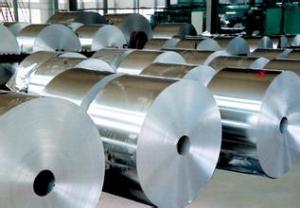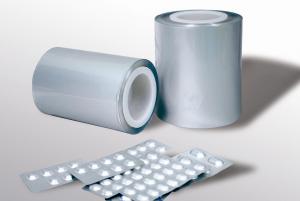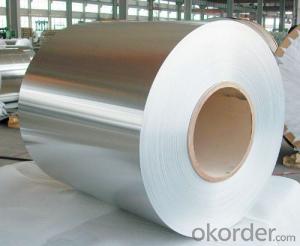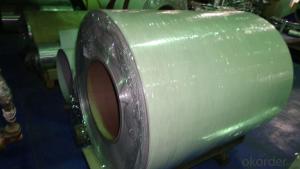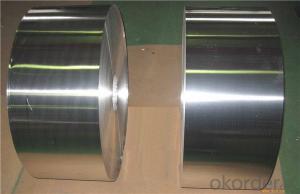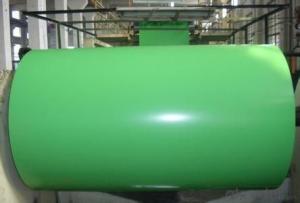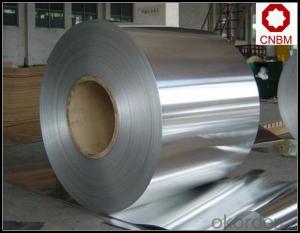ALUMINUM COIL
- Loading Port:
- China Main Port
- Payment Terms:
- TT OR LC
- Min Order Qty:
- -
- Supply Capability:
- -
OKorder Service Pledge
Quality Product, Order Online Tracking, Timely Delivery
OKorder Financial Service
Credit Rating, Credit Services, Credit Purchasing
You Might Also Like
ALLOY: AA1***
AA3***
AA5***
TEMPER: H14 H16 H18 H22 H24 H26 H32 O/F
THICKNESS:0.03MM-3.0MM
WIDTH: 30MM-1700MM
COATING: PE(POLYESTER),PVDF,EPOXY
STANDARD: GB/T 17748-1999
- Q:How are aluminum coils joined in a continuous process?
- Aluminum coils are joined in a continuous process using various techniques such as welding, brazing, and adhesive bonding. Welding is a common method used to join aluminum coils together. It involves melting the edges of the coils and then fusing them together. This can be achieved through various welding processes such as TIG (Tungsten Inert Gas) welding, MIG (Metal Inert Gas) welding, or laser welding. These methods provide a strong and durable bond between the coils. Brazing is another technique used for joining aluminum coils. It involves heating the coils and using a filler material with a lower melting point than the aluminum to create the joint. The filler material, often a brazing alloy, is applied to the joint area, and when heated, it melts and flows into the gap between the coils, forming a solid bond upon cooling. Adhesive bonding is also employed in the continuous joining of aluminum coils. This method involves applying a specialized adhesive or glue to the surfaces of the coils that need to be joined. The adhesive is carefully selected to have excellent bonding properties with aluminum. The coils are then pressed together, and the adhesive cures, creating a strong and reliable bond. Each joining technique has its advantages and is chosen based on factors such as the application requirements, the type of aluminum being used, and the desired level of strength and durability. The choice of joining method in a continuous process depends on the specific needs of the production line and the final product.
- Q:Can aluminum coils be used in the production of sporting goods?
- Yes, aluminum coils can be used in the production of sporting goods. Aluminum is a lightweight and durable material that is commonly used in the manufacturing of various sporting goods such as baseball bats, tennis rackets, golf clubs, and bicycles. Aluminum coils are often used as a raw material in the production process to create the desired shape and structure of these sporting goods. The use of aluminum in sporting goods offers numerous advantages, including improved performance, increased durability, and enhanced weight distribution. Additionally, aluminum is resistant to corrosion, which makes it ideal for outdoor sporting activities. Overall, aluminum coils are widely utilized in the production of sporting goods due to their versatility, strength, and ability to enhance the overall performance of these products.
- Q:What are the common safety precautions when working with aluminum coils?
- When working with aluminum coils, it is important to follow several safety precautions to ensure the well-being of individuals and prevent accidents. Some common safety precautions when working with aluminum coils include: 1. Personal Protective Equipment (PPE): Always wear appropriate PPE such as safety goggles, gloves, and aprons when handling aluminum coils. This protective gear helps protect against potential injury from sharp edges, cuts, or burns. 2. Proper Handling Techniques: Use proper lifting techniques to avoid strain or injury. Aluminum coils can be heavy, so it is essential to lift with your legs, not your back, and use lifting aids or equipment if necessary. 3. Secure Storage: Store aluminum coils securely to prevent them from falling or rolling. Avoid stacking coils too high to prevent them from toppling over and causing injuries. 4. Proper Ventilation: Ensure that the work area has adequate ventilation to prevent the buildup of fumes or dust particles. Aluminum coils may release harmful particles or gases when cut or processed, so proper ventilation is crucial for maintaining a safe working environment. 5. Fire Safety: Aluminum is highly flammable, so it is vital to prevent sparks or open flames near aluminum coils. Use non-sparking tools and avoid smoking or using flammable materials in the vicinity. 6. Sharp Edges: Be cautious of sharp edges on aluminum coils, as they can cause cuts or lacerations. Handle coils with care and use appropriate tools to mitigate the risk of injury. 7. Training and Safety Guidelines: Ensure that all personnel working with aluminum coils are properly trained in handling procedures and safety guidelines. This includes understanding the correct use of equipment, emergency procedures, and knowledge of any specific hazards associated with aluminum coil handling. 8. Regular Maintenance: Maintain equipment and tools regularly to ensure they are in good working condition. This includes inspecting and repairing any damaged or worn-out parts that could pose a safety risk. 9. First Aid and Emergency Response: Keep a well-equipped first aid kit nearby and ensure that employees are aware of its location. In addition, establish clear emergency response protocols and train employees on what to do in case of an accident or injury. By adhering to these common safety precautions, individuals can minimize the risks associated with working with aluminum coils and create a safer working environment.
- Q:What are the different types of end conditions for aluminum coils?
- The different types of end conditions for aluminum coils include plain end, slit end, trimmed end, and sheared end.
- Q:Please tell me the the size of the piece of aluminum that you give the weight messurements.
- This Site Might Help You. RE: How much does Pure Aluminum weight, and what is its density or durability? Please tell me the the size of the piece of aluminum that you give the weight messurements.
- Q:Can aluminum coils be used in automotive manufacturing?
- Yes, aluminum coils can be used in automotive manufacturing. Aluminum is a lightweight and durable material, making it a suitable choice for various automotive components such as body panels, engine parts, and heat exchangers. Its corrosion resistance and recyclability also make it an attractive option for the automotive industry.
- Q:Can aluminum coils be used in refrigeration systems?
- Yes, aluminum coils can be used in refrigeration systems. Aluminum is a popular choice for coil materials in refrigeration systems due to its excellent heat transfer properties and corrosion resistance. Aluminum coils are lightweight, durable, and efficient in transferring heat, making them suitable for use in various refrigeration applications such as air conditioning units, refrigerators, and freezers. Additionally, aluminum coils are easier to shape and install compared to other materials, making them a preferred choice for manufacturers.
- Q:im melting aluminum and what should i use for metal. cans will just oxygenize( i forget the word for it sorry)
- aluminum, in general, will just oxidize if heated in air. it is not just cans that behave that way when they (alcan, alcoa) smelt aluminum industrially they keep it in a reducing environment and do not allow molten aluminum to contact air. so use any aluminum you like but prevent it from contacting air.
- Q:Are there any limitations on the welding or soldering of aluminum coils?
- Yes, there are limitations on the welding or soldering of aluminum coils. Aluminum is a highly reactive metal with a low melting point, which makes it challenging to weld or solder compared to other metals. One limitation is the formation of oxide layers on the surface of aluminum, which inhibits the formation of strong bonds during welding or soldering. These oxide layers need to be removed before the process, typically by using chemical cleaning agents or mechanical methods, such as abrasive cleaning. Another limitation is the high thermal conductivity of aluminum, which causes rapid heat dissipation. This can make it difficult to achieve and maintain the required temperature for welding or soldering. Specialized equipment and techniques, such as using high-frequency welding or preheating the aluminum, may be necessary to overcome this limitation. Additionally, aluminum has a tendency to deform or warp easily when exposed to high temperatures. This can lead to distortion or changes in the shape of the coils during the welding or soldering process. Proper clamping or fixturing techniques are often required to minimize distortion and maintain the desired shape of the coils. Furthermore, the use of filler materials in welding or soldering aluminum coils can also be challenging. Aluminum has a relatively high thermal expansion coefficient, meaning it expands and contracts significantly with changes in temperature. This can result in cracks or weak joints if the filler material does not have a similar thermal expansion coefficient to aluminum. Specialized filler materials, such as aluminum-silicon alloys, are often used to address this limitation. Overall, while welding or soldering aluminum coils is possible, it requires specialized knowledge, techniques, and equipment to overcome the limitations associated with the material's reactivity, heat dissipation, deformation, and filler material selection.
- Q:How are aluminum coils used in the production of cookware?
- Aluminum coils are used in the production of cookware as they are rolled into thin sheets and then formed into various shapes like pots, pans, and trays. These coils are lightweight, conduct heat efficiently, and have excellent heat distribution properties, making them ideal for cookware manufacturing. Additionally, aluminum's non-reactive nature ensures that it does not alter the taste or quality of the food being cooked.
1. Manufacturer Overview |
|
|---|---|
| Location | |
| Year Established | |
| Annual Output Value | |
| Main Markets | |
| Company Certifications | |
2. Manufacturer Certificates |
|
|---|---|
| a) Certification Name | |
| Range | |
| Reference | |
| Validity Period | |
3. Manufacturer Capability |
|
|---|---|
| a)Trade Capacity | |
| Nearest Port | |
| Export Percentage | |
| No.of Employees in Trade Department | |
| Language Spoken: | |
| b)Factory Information | |
| Factory Size: | |
| No. of Production Lines | |
| Contract Manufacturing | |
| Product Price Range | |
Send your message to us
ALUMINUM COIL
- Loading Port:
- China Main Port
- Payment Terms:
- TT OR LC
- Min Order Qty:
- -
- Supply Capability:
- -
OKorder Service Pledge
Quality Product, Order Online Tracking, Timely Delivery
OKorder Financial Service
Credit Rating, Credit Services, Credit Purchasing
Similar products
New products
Hot products
Hot Searches
Related keywords
